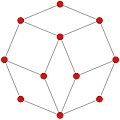Hidden line
This article has multiple issues. Please help improve it or discuss these issues on the talk page. (Learn how and when to remove these messages)
|
In mathematics, a hidden line is a geometric edge line[1] that is not visible from an observer's view of a shape or object.
A common practice is to draw the visible edges as solid lines and the hidden lines as dotted lines, dashed lines,[2] or thinner lines than the visible lines.

Hidden lines add geometric information about the unseen sides of an object. They are used to help a person visualize drawings of geometric objects in three-dimensional space.[3]

A three-dimensional object drawn with solid visible and hidden lines is a wire-frame model of the object.
Geometry objects without hidden lines
[edit]When a student is first introduced to a geometric cube, a cube without hidden lines looks like a closed box which they are familiar. Drawing an object without hidden lines, matches an observer's view of the object.[4] Less lines makes an object easier to draw.
To draw higher dimensional cubes, hypercubes, without hidden lines, make the faces opaque. Then, the hidden lines are no longer visible, they are removed from the observer's view. This works with a cube in three-dimensional space, a Tesseract in four-dimensional space, a hypercube in five-dimensional space, and will work with higher dimensions as well.
Hidden lines in technical drawings
[edit]Hidden lines represent edges of a physical object that are not visible from a specific viewpoint. Visible lines are viewable edges from a specified viewpoint. In a technical drawing hidden lines are either included or not included, depending on the viewer’s requirement.
"Hidden lines are used in engineering drawings to represent features that cannot be seen in a particular view but are necessary to fully define the part or assembly. Hidden lines are represented by a series of short dashes, evenly spaced, with the first dash in contact with the visible line from which it starts and the last dash in contact with the visible line at which it ends."[5]
In a computer drawing application, the hidden line option may be referred to as a wire frame with hidden edges.[6] The wireframe hidden edges would be dashed lines.

Removing hidden lines is important in computer design and graphics applications. There are algorithmic solutions to remove hidden lines or partially hidden lines during an object's rendering. "The general problem of efficiently and meaningfully displaying three-dimensional objects in two dimensions is central to computer graphics."[7] [8]

See also
[edit]- Hidden-surface determination
- Technical drawing
- Perspective Drawing of Surfaces with Hidden Line Removal The arXiv article is written in Spanish. PDF English translation.
References
[edit]- ^ Weisstein, Eric W. "Polytope Edge". From Wolfram MathWorld.
- ^ TeX software(TeX), Draw cube with dashed hidden lines. From TeX StackExchange.
- ^ "...needed to make the drawing clear", Hidden Lines and Centerlines, Modern Graphics Communication, 5th Edition
- ^ "Hidden lines are omitted from pictorial drawings unless they are needed...", Hidden Lines and Centerlines, Modern Graphics Communication, 5th Edition
- ^ Engineering Design Graphics, Line Conventions, and Hidden Lines, Robert Hewitt, Associate Professor at the University of Memphis
- ^ Line Types in Technical Drawings YouTube video
- ^ Perspective Drawing of Surfaces with Hidden Line Removal(in Spanish)
- ^ Perspective Drawing of Surfaces with Hidden Line Removal(PDF English translation)









